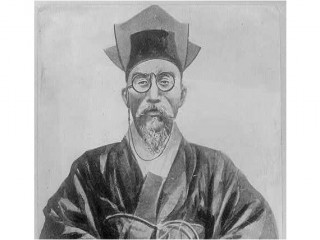
Kojong biography
Date of birth : -
Date of death : -
Birthplace : Korea
Nationality : Korean
Category : Historian personalities
Last modified : 2011-10-11
Credited as : twenty-sixth king of the Yi dynasty, Sunjong, Yi T'aewang
Kojong (1852-1919) was the twenty-sixth king of the Yi dynasty of Korea. He ascended the shaky Korean throne at the age of 12 and attempted in vain to defend the kingdom from external encroachments.
Kojong was the second son of Húngsón Taewóngun, whose consort was Myóngsóng Hwanghu, or Queen Min. Though Kojong ascended the throne in 1863, when King Ch'óljong died without an heir apparent, his father exercised the governmental power as the imperial regent for 10 years. Kojong inaugurated his personal rule in
1873, when Ch'oe Ikhyón criticized the regent's many blunders. By then, however, many members of Queen Min's family were exercising much of the governmental power.
Following the Korean attack on a Japanese navel vessel at the island of Kanghwa in 1875, the Korean government was obliged to enter into a treaty relationship with Japan. This marked the end of the isolationist policy initiated by Taewóngun. An observation and study mission was dispatched to Japan in 1881 to learn about the modernization measures of Japan. At the urging of the government of Ch'ing China, which feared Korea's exclusive treaty relationship with Japan, Korea concluded treaties with the United States, Great Britain, Germany, and France.
Within Korea, the struggle between the pro-Chinese conservative faction and the pro-Japanese progressive faction intensified. The political upheaval of the Kapsin Year was engineered by Kim Ok-kyun and others in 1884. The Tonghak (Eastern Learning) rebellions broke out in 1894, leading to the dispatch of Chinese and Japanese troops, who were subsequently to fight the Sino-Japanese War. The Japanese victory in the war was followed by the reform of the Kapo Year, launched by the Cabinet of Kim Hong-jip. When the pro-Japanese forces in the Korean capital appeared to be curbed by the counter-measures taken under the leadership of the pro-Chinese Queen Min family, the Japanese precipitated the incident of the Ŭlmi Year (1895). Queen Min was murdered in the incident, and a pro-Japanese Cabinet was again formed in Seoul. The following year Kojong took the
unprecedented step of seeking safety by staying in the Russian legation in Seoul.
Kojong felt safe enough to return to the Dóksu Palace in 1897. Japan, which emerged victorious from the Russo-Japanese War of 1904-1905, forced in 1905 the Ŭlsa Treaty on the Korean government, which compelled Korea to relinquish control of its foreign relations to Japan. Thus Korea became a virtual protectorate of Japan, which proceeded to disband the Korean army. Through an emissary, Kojong attempted to appeal to the international community at the Hague Convention of 1907 for assistance, but Japan blocked any action on Korea's behalf.
Incensed by the dispatch of the Korean emissary, Japan forced Kojong to abdicate in favor of Sunjong, the last king of Korea. After the formal Japanese annexation of Korea in 1910, Kojong was called Yi T'aewang. It has been said that Kojong's death in 1919 came as a result of his having been poisoned by the Japanese. The occasion of his funeral touched off the nonviolent, Korea-wide demonstration for independence, or the March First movement of 1919, which the Japanese suppressed ruthlessly.
Several chapters touching on the period of King Kojong are in Clarence Norwood Weems's edition of Homer B. Hulbert, History of Korea (1962). A personal narrative of intimate contacts with Kojong and some of the highlights of his eventful reign are in Fred Harvey Harrington, God, Mammon, and the Japanese (1944). □
















